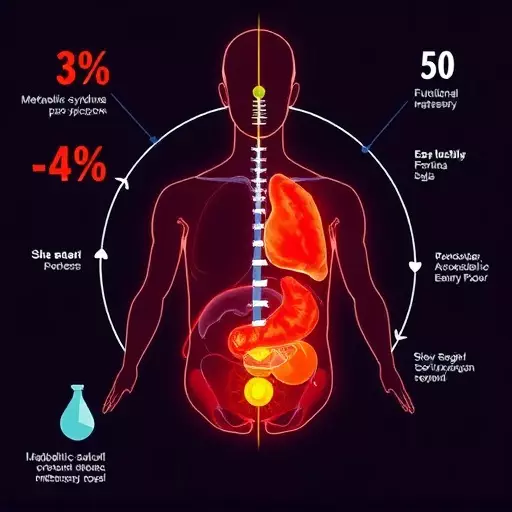In Indianapolis-Carmel-Anderson, functional medicine practitioners emphasize reversing metabolic syndrome using innovative strategies. High-Intensity Interval Training (HIIT) is a key tool, offering short bursts of intense exercise for improved insulin sensitivity, fat burning, and blood sugar stabilization. HIIT's effectiveness in managing metabolic health makes it a popular choice for achieving functional approaches to blood sugar stabilization and reducing type 2 diabetes risk.
“Unleash your body’s metabolic potential through High-Intensity Interval Training (HIIT), a game-changing strategy in the realm of functional medicine. This dynamic approach, popular among Indianapolis-Carmel-Anderson experts, offers a powerful solution for improving health and reversing conditions like metabolic syndrome.
In this comprehensive guide, we explore how HIIT’s short bursts of intense exercise enhance metabolic flexibility, boost blood sugar stabilization, and contribute to optimal overall health. Discover the science behind these workouts and learn practical tips to integrate HIIT into your routine.”
- Understanding Metabolic Flexibility and Its Impact on Health
- High-Intensity Interval Training (HIIT): A Functional Medicine Approach
- Reversing Metabolic Syndrome with HIIT Workouts
- How HIIT Improves Blood Sugar Stabilization
- Benefits of HIIT for Overall Metabolic Health
- Integrating HIIT into Your Routine: Tips from Indianapolis Experts
Understanding Metabolic Flexibility and Its Impact on Health

Metabolic flexibility refers to our body’s ability to adapt and efficiently utilize various energy sources based on physical demands and availability. It involves a dynamic interplay between carbohydrate, fat, and protein metabolism, enabling us to switch fuel sources seamlessly. This adaptability is crucial for maintaining optimal health and performance. When metabolic flexibility is compromised, as often seen in conditions like metabolic syndrome, the body struggles to respond effectively to changing energy needs, leading to issues such as insulin resistance, elevated blood sugar levels, and increased risk of chronic diseases.
In the context of functional medicine in Indianapolis-Carmel-Anderson, reversing metabolic syndrome with functional protocols is a key focus. These protocols often involve high-intensity interval training (HIIT) as a powerful tool. HIIT has been shown to improve insulin sensitivity, enhance fat burning, and promote better blood sugar stabilization—all essential elements for restoring metabolic flexibility. By adopting functional approaches to blood sugar stabilization, individuals can take control of their health and reduce the risk of developing more serious metabolic-related conditions.
High-Intensity Interval Training (HIIT): A Functional Medicine Approach

High-Intensity Interval Training (HIIT) has emerged as a powerful tool in the realm of Functional Medicine, offering a game-changing approach to improving metabolic flexibility and overall health. This training method involves alternating periods of intense exercise with brief recovery intervals, creating a dynamic and efficient workout routine. In Indianapolis-Carmel-Anderson and beyond, functional medicine practitioners have been utilizing HIIT as a strategy to combat metabolic syndrome—a cluster of conditions that includes elevated blood pressure, high cholesterol, and insulin resistance.
By reversing these conditions through functional protocols, HIIT helps stabilize blood sugar levels, promote weight loss, and enhance cardiovascular health. The key lies in its ability to stimulate various energy systems simultaneously, increasing fat burning during exercise while also improving insulin sensitivity. This functional approach to fitness is particularly beneficial for individuals seeking natural solutions to manage their health, as it avoids heavy reliance on medications and focuses on the body’s inherent capacity for healing and adaptation.
Reversing Metabolic Syndrome with HIIT Workouts

Metabolic Syndrome, a group of interconnected conditions including high blood pressure, elevated cholesterol, and insulin resistance, is a growing concern in today’s society. Traditional approaches to managing this condition often involve a combination of medication and lifestyle changes. However, functional medicine in Indianapolis-Carmel-Anderson offers a different perspective with a focus on reversing metabolic syndrome through functional protocols like High-Intensity Interval Training (HIIT).
HIIT workouts are designed to push the body beyond its typical aerobic zones, stimulating various physiological responses that can lead to improved metabolic flexibility. By alternating between intense bursts of exercise and brief recovery periods, HIIT promotes fat burning, enhances insulin sensitivity, and optimizes blood sugar stabilization. These functional approaches to blood sugar stabilization not only help in managing Metabolic Syndrome but also reduce the risk of developing type 2 diabetes and cardiovascular diseases, offering a holistic solution for overall health and well-being.
How HIIT Improves Blood Sugar Stabilization

High-Intensity Interval Training (HIIT) has emerged as a powerful tool in the realm of functional medicine in Indianapolis-Carmel-Anderson, and beyond. This training method involves short bursts of intense exercise alternated with brief recovery periods. The strategic intensity and duration of HIIT workouts stimulate various physiological processes that contribute to improving metabolic flexibility. One significant benefit is its positive impact on blood sugar stabilization.
By challenging the body with intermittent high-intensity efforts, HIIT helps enhance insulin sensitivity, which is crucial for reversing metabolic syndrome with functional protocols. This means that muscles become more responsive to insulin, allowing for better glucose uptake and utilization. As a result, blood sugar levels become more stable, reducing the risk of both insulin resistance and type 2 diabetes. Functional approaches to blood sugar stabilization, like HIIT, offer a dynamic and efficient method to manage metabolic health, as evidenced by its growing popularity in functional medicine practices across the country.
Benefits of HIIT for Overall Metabolic Health

High-Intensity Interval Training (HIIT) has emerged as a powerful tool in the realm of functional medicine in Indianapolis-Carmel-Anderson, offering significant advantages for overall metabolic health. By integrating short bursts of intense exercise with periods of active recovery, HIIT challenges the body in unique ways, fostering improvements in insulin sensitivity and glucose metabolism. This is particularly beneficial for individuals aiming to reverse metabolic syndrome with functional protocols, as it helps in achieving blood sugar stabilization.
The efficiency of HIIT lies in its ability to maximize calorie burn during a relatively short workout duration. This not only promotes weight management but also enhances the body’s ability to utilize and store energy effectively. For those seeking functional approaches to blood sugar stabilization, HIIT can play a pivotal role in improving metabolic flexibility, thereby reducing the risk of type 2 diabetes and other related conditions.
Integrating HIIT into Your Routine: Tips from Indianapolis Experts

Integrating high-intensity interval training (HIIT) into your fitness routine can be a game-changer for metabolic health, especially when guided by experts in functional medicine in Indianapolis-Carmel-Anderson. This form of exercise has gained popularity due to its effectiveness in reversing metabolic syndrome with functional protocols. HIIT involves short bursts of intense exercise followed by brief recovery periods, providing a powerful tool for achieving optimal fitness and wellness.
Indianapolis specialists recommend incorporating HIIT sessions into your weekly schedule, focusing on exercises that target multiple muscle groups. For instance, high-intensity interval training can include sprinting, burpees, mountain climbers, or cycling intervals. The key is to push yourself during the intense periods while maintaining a safe intensity level. Combining HIIT with a balanced diet and other functional approaches to blood sugar stabilization can lead to significant improvements in overall metabolic flexibility.
